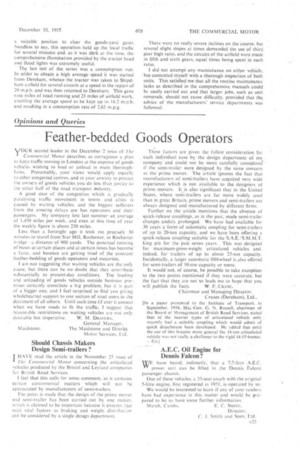Opinions and Queries
Page 63

If you've noticed an error in this article please click here to report it so we can fix it.
Feather-bedded Goods Operators
VOI.JR second leader inthe December .2 issue of The I Commercial Motor describes as outrageous a plan to keep traffic moving in London at the expense of goods vehicles wishing to load or unload in main thoroughfares. Presumably, your views would apply equally to other congested centres, and in your anxiety to protect the owners of goods vehicles you do less than justice to the other half of the road transport itdustry.
A good deal of the -congestion which is gradually paralysing traffic movement in towns and cities is caused by waiting vehicles, and the biggest sufferers from the ensuing delays are bus operators and their passengers. My company lost last sumener an average of 1.450 miles per week, and even at this time of year the weekly figure is about 250 miles.
Less than a fortnight ago it took me precisely 30 minutes to travel from Star Hill, Rochester, to Rochester bridge --a distance of 900yards. The punctual running. of buses at certain places and at certain times has become-a farce, and busmen are getting tired of the constant feather-bedding of goods operators and motorists.
I. am not suggesting that waiting vehicles are the only cause, but there can be no doubt that they contribute substantially to present-day conditions. The loading and unloading of goods vehicles outside business prenoses certainly constitute a big problem, but it is part or a bigger one, and I feel surprised to find you giving wholehearted support to one section of road users to the detriment of all others. Until such time (if ever it conies) when we have roads to fit the traffic. I suggest that reasonable restrictions on waiting vehicles are not only
desirable but imperative. W. M. DRAW RS,
General Manager.
Maidstone. The Maidstone and District Motor Services, Ltd.
Should Chassis Makers Design Semi-trailers ?
I HAVE read the article in the November 25 issue of Thc, Commercial Motor concerning the articulated vehicles produced by the Bristol and Leyland companies for British Road Services.
I feel that this calls for some comment, as it contains certain controversial matters which will not be appreciated by manufacturers of semi-trailers.
The point is made that the design of the prime mover and semi-trailer has been carried out by one maker, which is claimed to be important because it ensures that such vital factors as braking and weight distribution can be considered by a single design department.
These factors are given the fullest consideration for each individual ease. by the design department of my company and could not be More carefully considered-if the semi-trailer were designed by the same concern as the prime mover: The article 'ignores the fact that manufacturers of semi-trailers have a u ired very wide experience which is Mot available to the designers of prime movers. His also significant that in the United States, where semi-trailers are far more widely used than in great Britain, prime movers and semi-trailers are always designed and manufacturedby different firms.
Further on the article mentions that the absence of quick-release couplings, as in the past, made semi-trailer changes unduly ,prolonged. We have had available for 30 years a form= of automatic coupling for semi-trailers of up tb 20-ton capacity, and we have been Offering a quick:release coupling suitable for the S',A.E.
king pin for the past ,seem years. This was designed for 'maximum-gross-weight articulated vehicles and. indeed. for trailers of up to about 25-ton capacity. Incidentally, a larger automatic fifthwheel is,also offered for semi-trailers Of 50-ton capacity or more.
It would not, of course, be possibJe to take exceptio.n to the two points mentioned if they were accurate, but the fact that they are not=so leads me to hope= that you will publish the facts. • W. F... CRANE.
Chairman and Managing Director, Cranes (Derehain), Ltd., [In a paper presented to the Institute of Transport, in
September. I954,. Maj.-Gen, G. N. Russell, chairman of the Board of !Management of British Road Services.stated that in' the heavier types of articulated vehicle only recently had a suitable coupling which would admit of quick detachment been developed. He added that until the use-of this became more general the 14-ton articulated vehicle was not really a challenge to the rigid 14-151ormer. —ED.]
A.E.C. Oil Engine for Dennis Falcon?
WE have heard, indirectly, that -a 7:7-litre A.E.C.
power unit can be fifted to .the Dennis Falcon passenger. chassis.
One of these vehicles, a 33-seat coach with the original 5-litre engine, first registered in 1951, is operated by us.
We would be interested to learn if any of your readers have had experience. in this matter and would be prepared to let us have some further information.
March, Cambs. E. (7. SM 111 I , Director, C. J. Smith and Sons, Ltd.
















































































































